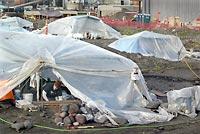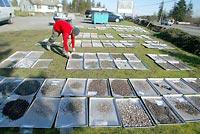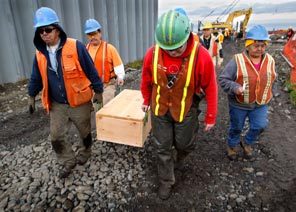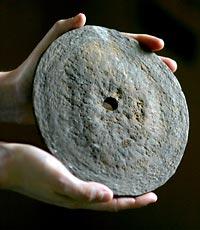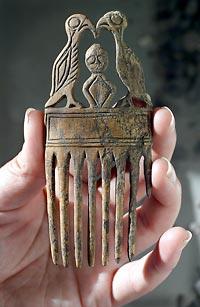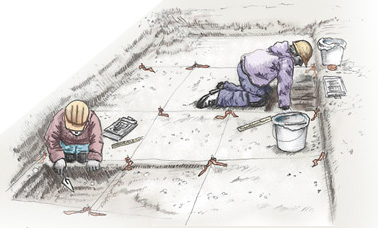Originally published May 22, 2005 at 12:00 AM | Page modified March 16, 2010 at 4:57 PM
From tools, shells and bones, a culture emerges
Unearthing Tse-whit-zen, Part 1: After a construction crew stumbled onto the ancient village, archaeologists and tribal members moved in to dig up shell pieces, bones, tools and other finds before closing up the site. It will take more than a year to analyze the thousands of artifacts.
Seattle Times staff reporter
STEVE RINGMAN / THE SEATTLE TIMES
A worker exhumes remains inside one of many tents covering graves of tribal ancestors so work can continue on a dry-dock project in Port Angeles. The state walked away from the site after spending $60 million and disturbing 335 intact burials. The rocks with red tape are headstones found with the remains and will be reburied with them.
More than 10,000 artifacts were found at the Tse-whit-zen site. Material is spread on trays to dry on the lawn in front of a house converted to an archaeology lab in Port Angeles.
Tribal spiritual adviser Mary Anne Thomas, far right, carries a lighted candle to escort human remains from the site to a construction trailer for temporary storage. The tribe wrapped the bones of their ancestors in white blankets and placed them in handmade cedar boxes. Any grave offerings found with the bones were kept with them.
STEVE RINGMAN / THE SEATTLE TIMES
The ancient village of Tse-whit-zen was one of at least 33 ancestral villages of the Klallam people on both sides of the Strait of Juan de Fuca. At first just a seasonal camp, Tse-whit-zen grew to a year-round village on prime land at the base of Ediz Hook. The same sheltered harbor drew the state to Port Angeles to build a dry dock. Metal walls still bracket the site of the canceled dry-dock project, center right.
PORT ANGELES — Down on his hands and knees, he swept the trowel back and forth across the dirt, led only by intuition.
"Something just told me, keep digging," said Lower Elwha Klallam tribal member Mark Charles, aka "Hammer," the nickname he earned as a guard on the high-school basketball court.
But with that trowel, its handle carved in the shape of a raven with a red "H" painted on the end, he was delicate, carefully pulling back the soil until something caught his fisherman's eye. It was a disc, carved out of whale vertebra. He brushed it off and called an archaeologist over to look.
The disc turned out to be a rare find in Puget Sound archaeology: an intact spindle whorl, used for spinning wool.
"At first I didn't really know what it was. You just knew it was special," said Charles, 37. "I've fished since I was 14. I'm used to following the fish upriver with my eyes — you train your eyes to see."But the bigger surprise was the archaeological site itself. For nearly 100 years, remnants of the ancient Klallam village lay buried — largely intact — under layers of industrial fill.
Then, in August 2003, a contractor digging up a piece of concrete for a state dry-dock construction project revealed a thick layer of broken shell underneath. It was the first glimpse of Tse-whit-zen, the largest Indian village ever found in the Puget Sound region.
Spindle whorl
Made from a whale vertebra, the spindle whorl found at Tse-whit-zen was used to spin yarn from mountaingoat wool, or perhaps twine from nettle fibers.
The spindle whorl was rotated like a flywheel on the leg, twisting the fibers into yarn or twine.
The archaeological dig grew to 3-½ acres. Construction of the dry dock, which was to have been used to build pontoons for the new east half of the Hood Canal Bridge, was abruptly halted in December 2004.
No other Washington site has yielded so rich an assemblage of artifacts from such a long period of time. Thousands of stone and bone tools, hearths, structures and houses document at least 2,700 years of continuous use of this thin arc of land.
Some of the graves found at Tse-whit-zen (pronounced ch-WHEET-son) may also document the first contact of Pacific Coast tribes with Europeans in the 1770s, and the diseases they brought.
"We usually get just a piece of a site. Here we get the whole thing: where the houses were, the cooking areas, the ceremonial areas, the drying racks — we have all of it," said Lynn L. Larson of Larson Anthropological Archaeological Services, hired by the state Department of Transportation to analyze Tse-whit-zen.
"For us, it's a once-in-a-lifetime opportunity."
For the Lower Elwha, who occupy a small reservation and have high unemployment, working at the Tse-whit-zen site meant not just steady, well-paid jobs, but discovery of their ancestral and spiritual home.
"Tse-whit-zen has been a blessing in a way," said Al Charles Sr., a tribal elder and Mark's uncle. "We are learning our history, our culture, our songs. People are joining hands that haven't talked in years."
"Part of my history"
For nine months, archaeologists and tribal members picked apart the Port Angeles site, using everything from a specially adapted excavator — they called it their "turbo trowel" — to tiny brushes and hand tools.
The digging stopped last December, after sampling just 4 percent of Tse-whit-zen. Archaeologists never dig an entire site: They practice a conservation ethic, digging only a fraction and saving the rest for future generations with new methods — and new questions.
Now the work has shifted to a run-down Port Angeles rental house converted to a lab. Inside, 14 archaeologists, self-described "shovel bums" from around the country, sort plastic bags of samples dug from the site: about 20,000 bags so far, with about 20,000 more to go.
Boxes and bags full of unsorted material fill the closets, stuff the basement and crowd the hallways, sometimes cascading in tumbles the staff calls "boxalanches."
At the peak of activity at the site, more than 100 tribal members worked with about 50 archaeologists.
"I wanted to figure it out. I was just a house mom, I didn't have a permanent job before all this started," said tribal member Amy Carter, 32, now an employee at the lab. "I was a night manager at a fast-food restaurant. But I wanted to know what was happening here — it was just curiosity.
"This is part of my history."
Carter started working at the site back in July 2004. She and other tribal members stood outdoors on an elevated platform all day, spraying water on material dug from the site, and sorting it on screens to find their ancestors' bones and belongings.
Today, at the lab, Carter works under a candle on the mantelpiece, kept lit in honor of her ancestors.
"I see myself as a caretaker. I wanted to know how these things were being taken care of. Actually identifying bones, looking at the etched stones, the projectile points, it makes me wonder. I think about the time and the patience it took to make them."
Slow going
Piecing together the story of Tse-whit-zen from what the ground has yielded also is slow going.On sunny days, the yard out front is covered with trays of drying material dug from the site. Inside, the house is filled with the sounds of skritching and scratching as archaeologists pick through dried gravel and sediment, looking for artifacts and tiny fragments of shell and bone.
Bone comb
Bone combs are a rare find at Northwest coastal archaeological sites. This one, carved on both sides, was probably used for grooming and as a hair ornament. It is thought to be made from elk or deer bone.
Tribal members were amazed that something so fine and fragile could have been found in the ground after so many years.
Eight hours' work might fill a half a cup of material to be further catalogued and analyzed: pieces of bay-mussel shell, sea-urchin spines, the hinges of clams, rockfish teeth.
It will take about another year just to sort through it all.
Once analyzed, this data will tell a story: what was in the environment of these ancient people; what they hunted; what they fished for; the tools and art they crafted; how they lived.
Already, archaeologists can tell that Tse-whit-zen was settled on prime land at the base of Ediz Hook, a curved spit jutting from the downtown waterfront.
The hook grew to cradle a deep-water bay, backed by lush forests with freshwater springs, and alive with deer, elk and birds. Salmon, herring and halibut teemed in the bay, and the beach was studded with mussels, oysters and clams. Whales cruised close by the beach, and the skies were alive with ducks.
At least 400 years ago, maybe earlier, Tse-whit-zen began growing from a seasonal camp into a substantial year-round village.
Post molds — the marks made by long-gone posts in the ground — depict the outlines of drying racks, built on the beach to dry fish and clams. The outlines of smokehouses, along with rock ovens, cooking hearths and some 4,000 stone fish-cutting tools are testimony to the bounty that sustained this village.
With the luxury of abundant food stores, December and January meant time off to enjoy long winters in residence at Tse-whit-zen. There was time for visiting and storytelling around the fire, and repairing tools. There were also elaborate potlatches lasting a week or more, devoted to feasting, dancing, singing and gift-giving.
Spring, summer and fall were for gathering and preserving food, with most tribal members dispersed to fish, pick berries or hunt.
Thousands of stone and bone tools recovered from Tse-whit-zen show its residents' mastery of their environment.
Tribal member Michael Q. Langland saved a special dance just for the bone points he found in abundance at the site.
Noticing a bit of bone protruding from a pile of dirt, he once found a 10-inch-long harpoon point for hunting sea mammals. "I held it straight out, raised it over my head, and did my dance.
"When you found something really cool like that, you would go around to each spot, and show it to everyone. It was one of those that made me flash back in time, and think, who made this? What type of person? What did he use it for?"
The ground itself was powerful, Langland said.
He recalled pausing once in his work, stunned by a sense of connection to his ancestral home. "I would think, 2,000 years ago, our ancestors were standing on this very spot, right here. This was their home, this was their place, where they hunted and fished. It was overwhelming."
A glimpse of village life
Archaeologists have discerned several distinct areas of the village, Larson said.
Fish and clams were cleaned on the beach, where the tide could sweep the sand clean. Further back, houses were built in a line along the beach berm. Cooking facilities were placed behind them and outbuildings farther back, including a possible menstrual hut where women would have spent their monthly period in seclusion.
Archaeologists may also have found the remains of a wooden stockade, where upper-class members could take shelter from raiding tribes, leaving slaves and lower-class members to their fate on the beach.
The discovery of 17 human skulls, apparently the spoils of victory, leaves no doubt as to the Klallam people's legendary prowess as warriors. Each skull has a hole in the top, where they had probably been stuck on a post on the beach to warn rival tribes.
"That's a trophy case," says tribal member Lonnie Charles.
Many of the artifacts and remains testify to the tribe's rich artistic and spiritual life and complex social-class system.
Skulls of some skeletons indicate that the elite gradually flattened the heads of their babies, tying a flat rock wrapped in cedar bark padding to the infant's cradle board. The hoped-for sloped foreheads were regarded as a mark of great beauty and sign of high status.
Archaeologists also think the red-stained fire pits in the oldest known parts of the site are a clue to the tribe's early ceremonial life. Tribal members used heat to dry and reduce red clay to an ochre powder that they dusted over the dead for protection in the spirit world.
Tribal members are believed to have mixed the red powder with deer tallow and wore it as face paint during the winter spirit dances. The dances invoked an infinite array of spirit powers: the gift of prophecy; the power to see great distances; the ability to call fish close to shore; the power to acquire many wives or husbands, control the weather, run fast or be brave in war.
Wealth of information
Archaeologists hope to answer many questions at Tse-whit-zen: When did it became a year-round village? Was the village suddenly abandoned, and if so, why?
One of the most eagerly anticipated answers is whether a large number of skeletons, hastily buried, are evidence of an epidemic that wiped out much of the tribe when European explorers first landed on the Olympic Peninsula more than two centuries ago.
Already, archaeologists have been surprised by the richness of the artifacts at Tse-whit-zen, with its trove of stone and bone tools, etched stones and ochre manufacturing pits.
The intact layers of archaeological deposits allow scientists to read epochs of time at Tse-whit-zen like a book.
"The wealth of information, the richness of the artifacts, it takes your breath away," said Randy Crones, an archaeologist from Boston.
For the Lower Elwha, Tse-whit-zen also makes tangible the stories passed down from generation to generation.
"It's proof," said tribal member Wendy Sampson. "It is not just a story. It's over 10,000 artifacts and 300 burials to prove we were there — for a long time."
Lynda V. Mapes: 206-464-2736 or lmapes@seattletimes.com
Steve Ringman: 206-464-8143 or sringman@seattletimes.com
UPDATE - 09:46 AM
Exxon Mobil wins ruling in Alaska oil spill case
NEW - 7:51 AM
Longview man says he was tortured with hot knife
Longview man says he was tortured with hot knife
Longview mill spills bleach into Columbia River
NEW - 8:00 AM
More extensive TSA searches in Sea-Tac Airport rattle some travelers
![]()

Entertainment | Top Video | World | Offbeat Video | Sci-Tech
general classifieds
Garage & estate salesFurniture & home furnishings
Electronics
just listed
More listings
POST A FREE LISTING


